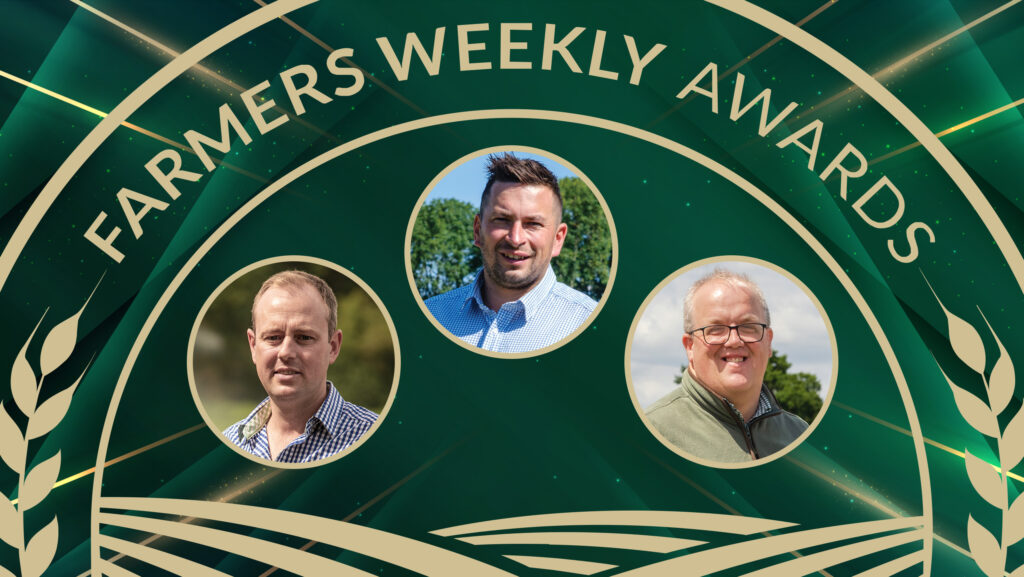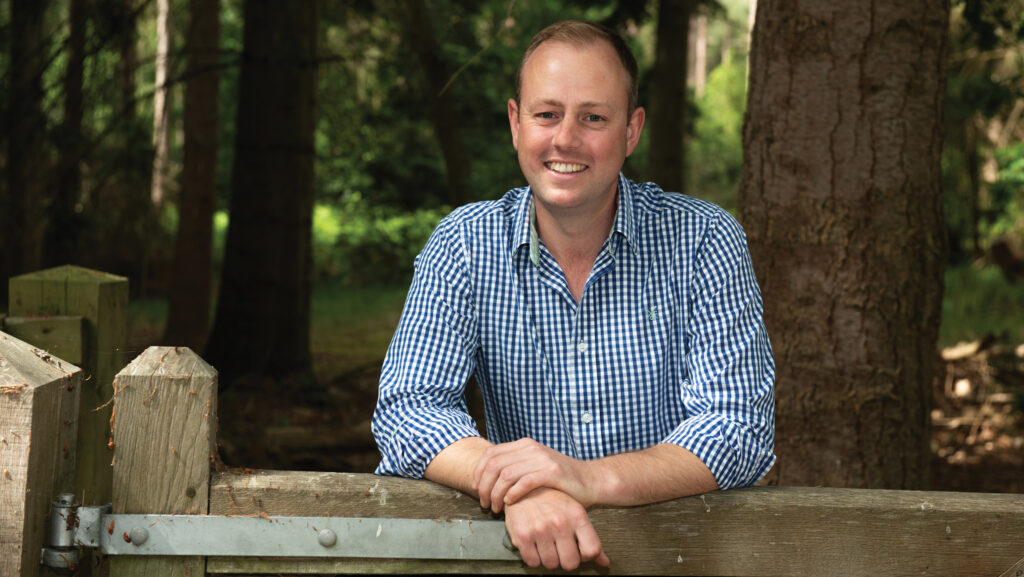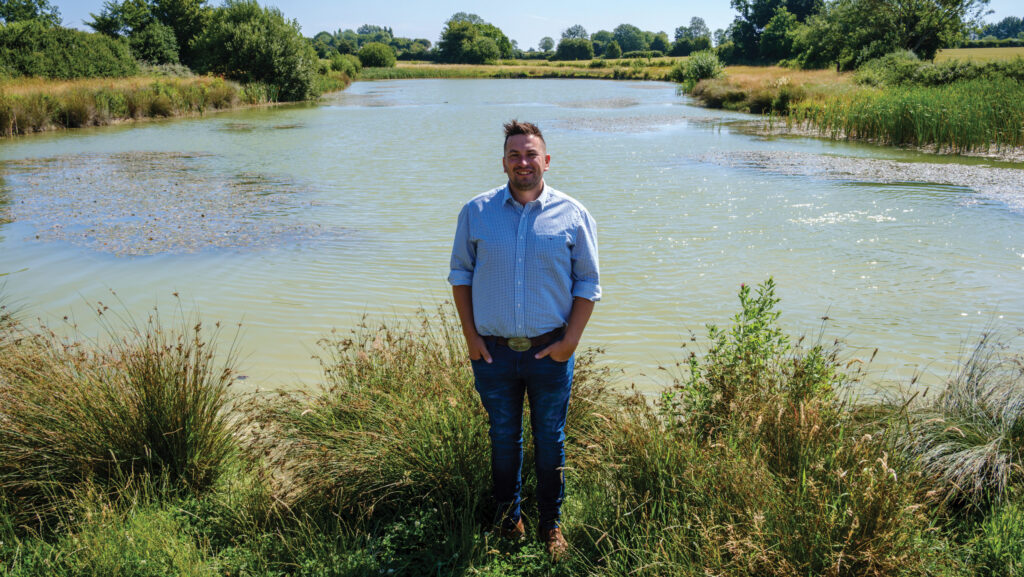FW Awards: Meet the 2025 Farm Manager of the Year finalists
 Left to right: Tom Forrest, Ryan McCormack, Neil Ridgway © Phil Weedon/Jason Bye/Kathy Horniblow
Left to right: Tom Forrest, Ryan McCormack, Neil Ridgway © Phil Weedon/Jason Bye/Kathy Horniblow This year’s farm manager finalists run very different businesses but share many challenges – and a determination to be the best in their field.
See also: FW Awards 2025: Meet the finalists
Finalists
- Tom Forrest, Frederick Hiam Ltd, Brandon Fields, Brandon, Suffolk
- Ryan McCormack, Dennington Hall Farms, Woodbridge, Suffolk
- Neil Ridgway, Stowell Farms, Marlborough, Wiltshire
The judges
- Al Brooks – independent judge Al is estate director at the Faccombe Estate in Hampshire. He is also FW’s 2010 Farm Manager of the Year.
- Breiffni Daly – last year’s winner Breiffni manages Sansaw Dairies, on the Sansaw Estate, Shropshire. He runs a team of 14 staff milking 1,500 cows.
- Suzie Horne – Suzie has been Farmers Weekly’s business editor since 2011, and former deputy editor of Big Farm Weekly.
Tom Forrest, Frederick Hiam Ltd, Brandon Fields, Brandon, Suffolk

Tom Forrest © Phil Weedon
Tom joined the business in 2021 as a farm manager with responsibility for the onion and parsnip crops, soon adding the potato crop, and in 2024 was promoted to senior farm manager.
He now manages a team of 20, including three assistant managers plus seasonal labour.
Tom is also part of the business’s executive management team considering long and short-term strategic decisions.
Budgeting, monitoring and financial reporting for the cropping are part of his remit. He has improved the accuracy of these as well as made technical and operational changes to improve profitability.
Tom has addressed internal challenges including underperforming crops, an ageing farm team and machinery fleet, alongside dealing with the many impacts of Covid.
He concentrates on areas that are possible to control, such as improving crop performance, finding and developing young people and improving the efficiency, reliability and running cost of machinery.
Better timing and attention to detail have contributed to improved crop and people performance, adding energy to the team as well as nurturing them.
The wide geographical spread of the cropped land demands meticulous planning of daily operations, added to by taking on 620ha of extra land in 2023.
Risk is reduced through partnerships and other collaborations for packing and marketing produce.
Innovation
In 2022, driven by Tom, root crop production was moved from 1.83m to 2m wide beds, giving a 5-10% increase in output.
Sprayers have been upgraded for the most accurate boom control, making sure the £800,000 annual agrochemical spend is deployed efficiently.
Tom also inherited a fleet of tractors at upwards of 10,000 hours so is streamlining this to John Deere units, with a plan to change these before they reach five years old.
Soil testing has been stepped up to improve potato quality for the specialist markets, while close attention to all operations, such as irrigation, ensures a place in the challenging market.
Tom’s enthusiasm for technology includes the introduction of a camera guided spot sprayer for weed control in onion and carrot crops, allowing more effective placement of a narrowing range of products.
Autonomous technology in the form of Robotti kit came onto the farm in 2023 initially as a seasonal demo, and the team are working with the manufacturer on improvements.
The system is also being used to monitor crop populations, helping to predict output.
Risk management
Climate change and the availability of water are related risks, so smarter abstraction and application is being worked on.
However, this often means increased people input, which is becoming more difficult in intensive production.
Tom is looking to automate where possible, but at the same time is keen to maintain a good working environment to keep the business attractive to potential recruits.
Market risk is spread by having a mix of contracted supply and pricing, alongside free-buy at differing volumes.
Staff approach
Different people respond to different types of motivation, something Tom clearly understands.
A range of initiatives has seen a profit related bonus scheme introduced, encouraged by Tom, alongside more employee engagement.
One of the company values is “ambitious” and, as such, Tom has promoted within his team to roles with more responsibility.
The numbers
- 2,500ha land
- 20 in Tom’s team, plus seasonal staff
- 350ha potatoes
- 380ha onions/shallots
- 200ha parsnips and carrots
- 350ha sugar beet
- 900ha cereals
- 65t/ha-plus average potato yield
Farm facts
- Large root crop and cereals business
- Owned land, farm business tenancy, contract farming agreements, cropping licences and crop management agreements
- Eight-year rotation to improve sustainability and reduce risk across four main cropping blocks
- Soil types from Breckland sand to clay
- Mid Tier and Sustainable Farming Incentive schemes
- Part of Breckland Farmers Wildlife Network Landscape Recovery pilot
The judges liked
- Both a leader and a team player
- Willingness to explore or invest in tech that is likely to become the norm in future
- Attitude to work/life balance
- Drive and enthusiasm to move the business forward, making sure everyone moves with it too
What the judges say
Tom has a go-ahead approach but pays close attention to the detail. He ensures his team members are on board and enjoys finding and encouraging the next generation of farm staff.
Ryan McCormack, Dennington Hall Farms, Woodbridge, Suffolk

Ryan McCormack © Jason Bye
Ryan McCormack joined Dennington Hall Farms early in 2022, having had 15 years’ farming experience in Kent.
His management approach – working closely with the Rous family, who own the farm – is based on improving soil health by reducing inputs and tillage alongside increasing livestock numbers and cropping diversity, to produce nutrient dense food.
Every opportunity to add value is taken.
Innovation and change
Ryan has made significant changes, always in line with the family’s commitment to sustainable, responsible farming.
The arable policy has moved away from a high input, intensive approach on the heavy clay soils to a regenerative system, including the introduction of a 12-year rotation in 12 blocks.
This incorporates overwinter cover crops, companion planting and more spring cropping.
The farm has grown for Wildfarmed for the past three seasons, with 80ha in milling wheat and malting barley for the brand this year.
As well as promoting soil health, his changes are also designed to make efficient sense of the 310 fields with an average size of 6ha.
This involved a complete machinery fleet overhaul and a move to 50% of fertiliser applied as liquid. Grant funding for a direct drill means that alongside other machinery changes, many crops are established on a zero-till basis.
Ryan has converted the farm’s mixed breed suckler herd to pedigree Red Poll.
Direct sales began this year, through meat boxes, restaurant supply and butcher-ready carcasses, and his plan is to expand from the current 30 cows to 80.
Venison from the five breeds of deer at Dennington Hall is also sold direct.
Cattle are slaughtered as locally as possible, and direct sales have increased the profit an animal significantly. A new livestock building is almost complete.
This will improve winter housing for the brand, which is planned to grow considerably. Remote fencing through the use of cattle collars has proved a successful recent innovation.
Marketing
As with the beef and venison sales, the focus is on local marketing, with a good proportion of the farm’s grain sold through the nearby Framlingham Farmers co-operative, including using its platform to sell 100-tonne lots on the futures market, consistently achieving prices £10/t above standard pool averages.
The increased cropping diversity also helps spread market risk, with weather risk reduced by establishing winter cereals into summer catch crops and overwintering cover crops before spring cereals.
Malting barley is sold to Muntons of Stowmarket, 30 minutes from the farm, while the beet travels for less than an hour to British Sugar in Bury St Edmunds. Mustard, grown on contract for Colmans, is a relative newcomer to the rotation.
Staff approach
A team restructure meant some early difficult decisions, but Ryan has now developed a positive culture. Staff have monthly one-to-one catch-ups with Ryan, as well as the daily 7.15 morning meeting.
He has introduced a comprehensive benefits package, team building events and upgraded staff facilities.
Salaries are benchmarked to ensure the farm is competitive.
Many other calls on Ryan’s time include being on the NFU’s crops board and Suffolk Coastal Branch chairman.
He hosts Open Farm Sunday and farm walks, and is a member of Suffolk Search and Rescue.
Looking ahead, he has plans for a new grain store and dryer, a dog walking field and is investigating private funding for soil, air and water management.
The numbers
- 1,200 area (ha) of regenerative arable land
- 310 fields
- 6ha average field size
- 60 cattle – 30 cows plus followers
- 12-year rotation and crop blocks
- 160km of hedges
Farm facts
- 1,600ha of which 1,200ha regenerative arable
- Mainly owned – 100ha of arable land is on a farm business tenancy. 200ha contract farming agreement on additional land
- Red Poll suckler herd
- Farm staff: assistant manager, two full-time operators, two part-time work experience students
- Mid Tier Countryside Stewardship agreement
- Four Sustainable Farming Incentive agreements
The judges liked
- Enthusiasm for implementing change
- Balancing profit with food quality, the environment and community needs
- Staff management and communication – inclusion, work-life balance, one-to-ones
- Engagement with public and farming initiatives and organisations
What the judges say
Ryan seeks the best from his team, the land and the market, addressing environmental imperatives at the same time. He is open and constructive, with a clear grasp of financial management.
Neil Ridgway, Stowell Farms, Marlborough, Wiltshire

Neil Ridgway © Kathy Horniblow
On joining the business in 2021, Neil made some quick decisions to improve financial performance.
Significant capital investments followed in 2023-24, including his suggested move to robotic milking, a new slurry lagoon and upgrading the anaerobic digestion (AD) plant.
The sheep flock was also expanded.
While each enterprise has to be profitable, he has integrated the main ones, improving long-term viability.
This has seen the dairy sell slurry to the digester, the AD sell electricity to the dairy, and export to the grid.
The AD buys dairy feed refusals and sells digestate to the arable; the arable sells feed to the dairy and cereals off farm.
The sheep enterprise needs the Sustainable Farming Incentive and stewardship incomes to make a profit, but complements the overall operation by using less favourable areas, such as downland in summer, and utilising cover crops and silage/lucerne leys over winter.
Innovation
The move to robotic milking is Neil’s biggest innovation and achievement, feeling that the system he inherited compromised cow welfare, performance and long-term sustainability, including future labour sourcing.
He has increased herd size from 480 cows to 780, with close health and performance monitoring so problems can be spotted early and addressed.
A reduction in milking standing time has improved cow comfort and cut foot health problems by a third. Mastitis cases are down to 29 in 100 cows compared with 42 before robots.
Breeding policy on Neil’s watch has concentrated on improving strength, robustness and production.
Animals have also been bought in from high-genetic merit herds. The aim now is to “purify the herd”, using genomic testing to select females for yield and milk solids, to make best use of the milk contract.
There has also been a close focus on calf health and colostrum management in particular, aiming to give three doses within 24 hours.
Forage management has been taken in-house, silage clamp waste has been virtually eliminated and a Triolet triotrac self-propelled feeder wagon has improved efficiencies and tracks ration mixing consistencies.
About 50% of cereals are rolled on farm and used in feed.
Market
The ewes are lambed over Easter to hit an autumn market. Lambing is both indoor and outdoor, with lambs finished at 42kg and sold direct to ABP.
The dairy is on an Arla contract and was asked by the co-op to host visits from Ferrero Rocher, Aldi and Costa to showcase what was achievable on a “big farm”.
Neil used this to help negotiate an Aldi contract worth an extra 0.75p/litre on the 9m litres of milk produced, thanks to the farm’s high environmental and animal health standards.
Staff
Effort is made to put the right people in the right roles, raising retention rates since Neil’s appointment.
Personality profiling has helped a wider team understanding of how different people work and take in information. Staff interested in showing are given the chance to get involved in this aspect of the business.
Environmental measures include introducing bird plots, habitat sites, bird boxes, hedgerow management, integrated pest management, lucerne, herbal leys and low input areas.
The farm hosts about 2,000 people every year, with some 800 visiting during Open Farm Sunday alone.
Expansion lies ahead – a planning application has been submitted for a new 220 cow shed with four more robots.
The numbers
- 1,600 cattle, including youngstock
- 12 Lely A5 Astronaut milking robots
- 12,500 average yield (litres a cow) at 4.01% fat, 3.21% protein
- 3,300 litres a cow a year of milk from forage
- 2,000 North Country Mules, two shepherds
- 42kg finished lamb weight
Farm facts
- 1,416ha total farmed area
- Dairy, arable and sheep enterprises
- 660ha of arable – maize, wholecrop rye, wheat, barley, oilseed rape, lucerne (for cows), herbal leys (for sheep), grass/clover silage leys
- 500kW AD (fed 90% dairy slurry, 3% maize) provides all dairy power, with remainder exported to grid
The judges liked
- Passion and commitment
- 3,700-litre jump in milk yield from 8,500 litres a cow a year to 12,200 litres
- Minimises risk by integrating enterprises, building efficiencies, sustainability and improving staff management
- Hosts many visits to farm
What the judges say
Neil demonstrates the passion, drive and ambition needed to manage a large and diverse farming business demanding profitable, sustainable performance, always with an eye to the next steps.
A word from our sponsor

“This award recognises managers who lead their teams with great skill, experience and vision, while ensuring the safety of each worker, protecting their employer and the business they are helping to build. ”
Oliver Dale, managing director, Safety Revolution
